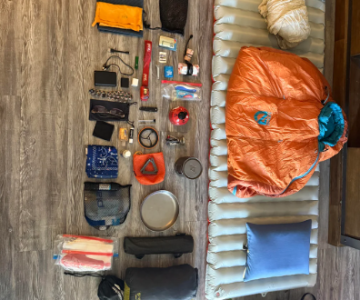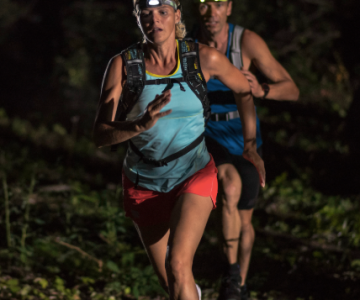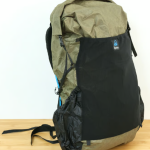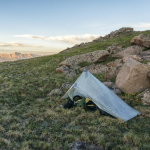Ultralight backpacking allows you to enjoy your hike with less strain and more speed, but reducing the weight of your pack isn’t as simple as picking lighter gear. To really shave off pounds, you need to adopt some smart, proven strategies for choosing the right equipment and packing efficiently. Whether you’re looking to trim a few pounds or aim for an ultra-low base weight, this guide will help you streamline your gear and make the most out of your hike.
Understand Base Weight vs. Pack Weight
Before diving into how to lighten your load, it’s important to distinguish between base weight and pack weight:
- Base weight refers to the weight of your gear that won’t change during the hike, such as your tent, sleeping bag, pad, and backpack. It excludes food, water, and fuel, which fluctuate as you use them. A base weight between 11 to 17 pounds is considered lightweight, while ultralight backpackers aim for 10 pounds or less.
- Pack weight includes everything—gear, food, water, and fuel. This weight varies, with your pack being heaviest at the start of a trip and lighter by the end. As a rule of thumb, your pack should never exceed 20% of your body weight.
Cut Down on Gear Weight
To make a significant difference in your base weight, focus on upgrading the four heaviest items: your tent, sleeping bag, sleeping pad, and backpack. If you can reduce the weight of these items, you’ll have a solid foundation for ultralight backpacking.
Example savings by upgrading your gear:
- Sleeping Bag: A synthetic 20° sleeping bag (2 lb 14 oz) can be replaced with an ultralight down sleeping bag (2 lb 6 oz), saving 1 lb 8 oz.
- Tent: Replace a mid-weight 2-person dome tent (3 lb 2 oz) with an ultralight 2-person A-frame tent (2 lb 2 oz), saving 1 lb.
- Sleeping Pad: Swapping a self-inflating pad (2 lb 5 oz) for an ultralight air pad (13 oz) saves another 1 lb 8 oz.
By upgrading just these three items, you could save around 4 pounds.
Upgrade Your Sleep System
One of the biggest weight-saving upgrades is switching from a synthetic sleeping bag to a down-filled sleeping bag. While synthetic fill has improved over the years, down (800 fill power and higher) is still much warmer and more compressible, leading to a significant reduction in weight. For even lighter options, consider down-filled backpacking quilts, which are lighter than sleeping bags and perfect for ultralight setups.
If you’re still using a self-inflating pad, consider upgrading to an ultralight air pad. Though these cost more, they offer superior comfort and save you weight compared to self-inflating pads. Alternatively, closed-cell foam pads are cheaper, more durable, and puncture-resistant, though less comfortable.
When choosing a sleeping bag and pad, think about your overall sleep system. Make sure it will provide adequate warmth in the coldest conditions you might face, and be willing to supplement with extra layers or liners for particularly chilly nights.
Opt for a Lighter Shelter
Selecting a lightweight shelter is crucial for reducing your base weight. If you’re hiking solo, a trekking pole tent or tarp can provide significant weight savings compared to a traditional tent. However, there are trade-offs to consider, like weather protection and condensation.
For a two-person setup, sharing the weight of a shelter is an effective way to halve the load. If hiking alone, you might need to go with a lighter option, such as a single-walled trekking pole tent or tarp. Here’s a breakdown of different shelter options:
- Big Agnes Copper Spur UL2 (2-person tent): 2 lb 14 oz
- Zpacks Duplex (1-person trekking pole tent): 16.5 oz
- Zpacks Flat Tarp 8.5’ x 10’: 12.5 oz
A tarp setup is incredibly light, but not as protective as a tent. However, a bivy bag can help protect you from rain, making it a solid choice for some. When deciding between a tarp or tent, weigh the benefits of protection against the reduced weight.
Streamline Essentials
Pack only what you need. Avoid carrying large quantities of consumables such as toilet paper, sunscreen, or toothpaste. Opt for smaller versions or repack into ziplock bags. For example, cut off the empty ends of toothpaste tubes and seal them with tape. This simple step can significantly reduce unnecessary bulk.
Minimize Non-Essential Gear
Every item in your pack should be essential. Ask yourself if an item really adds value to your trip. Do you really need a 20-piece multi-tool? Or can you do with a small knife? Consider alternatives like using your phone as a camera, map, and entertainment device to save weight. Ditch the bulky paperback and load your phone with e-books or use a digital map instead.
Embrace an Efficient Layering System
Layering is key to ultralight backpacking clothing. Choose clothes that serve multiple purposes and allow you to adjust based on the weather and your activity level. A typical layering system might include:
- Base Layer: Moisture-wicking synthetic or merino wool.
- Mid Layer: Fleece or a lightweight puffer jacket.
- Outer Layer: Waterproof jacket or poncho for rain protection.
Don’t pack excessive clothing—just enough to stay dry and comfortable. Keep one set of clothes reserved for camp and wear the same hiking clothes throughout the day. You’ll be surprised at how little you need and how much you can save by keeping it simple.
Go Light with Your Stove and Cookware
To save weight on cooking gear, you can skip the stove on short trips or share your stove with a friend. A solo traveler can opt for a compact stove, but make sure to also optimize your entire cooking system. Use a small pot, minimize the amount of fuel you carry, and avoid bringing unnecessary utensils like separate bowls. You can eat directly from your pot to save weight and reduce cleanup.
Manage Water Efficiently
Water is heavy, so plan your water refills carefully. Carry only what you need between water sources and avoid over-packing. On average, hikers need between 400-600 ml of water per hour in warm conditions. Plan your water needs based on your meal requirements and hiking pace.
Plan Light Meals and Snacks
Food is one of the heaviest parts of your pack, so be strategic. Opt for calorie-dense, lightweight meals such as freeze-dried or dehydrated food. Repackage meals into smaller portions to reduce bulk and packaging. Choose snacks like trail mix, energy bars, and dried fruit, and avoid carrying more food than you need.
Conserve Fuel
Stove fuel is another contributor to pack weight. Plan your fuel needs based on your meal plan, or use your past trips as a reference. Carry only the necessary amount, and avoid overpacking. If you can, share fuel and stove systems to further reduce weight.
Final Thoughts
Ultralight backpacking isn’t just about minimizing your gear; it’s about making smarter choices that enhance your experience while keeping your pack manageable. By focusing on the essentials, optimizing your gear, and employing smart weight-saving strategies, you can hike faster, farther, and with less effort. Ready to lighten your load? Start with these tips and enjoy the freedom that comes with an ultralight backpack.





